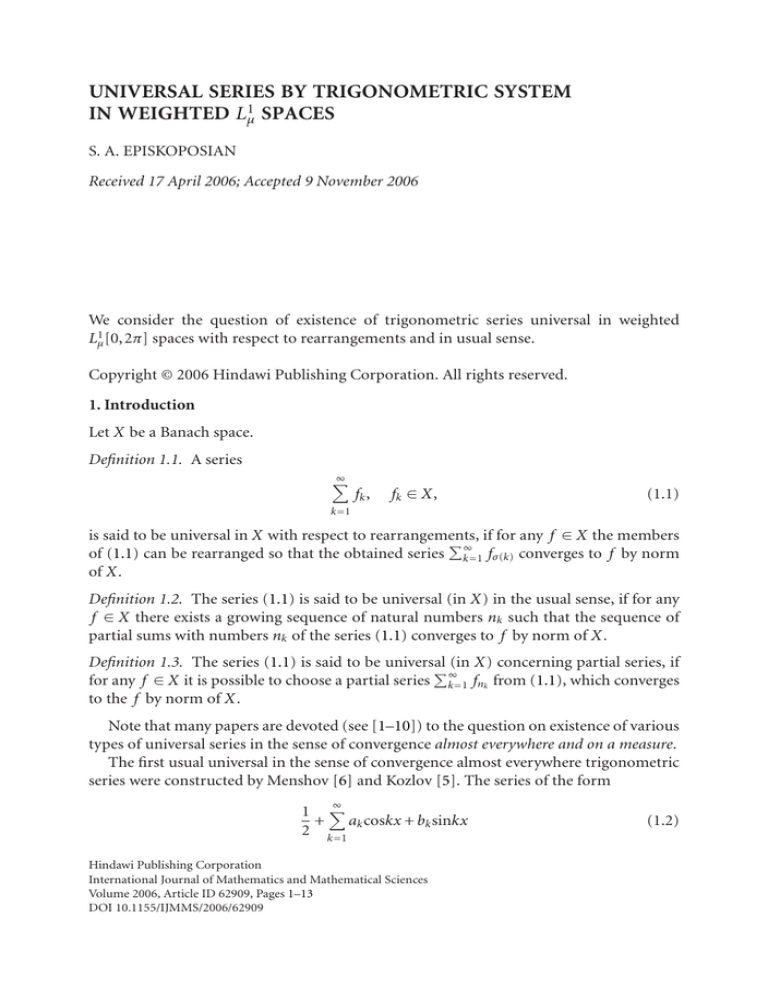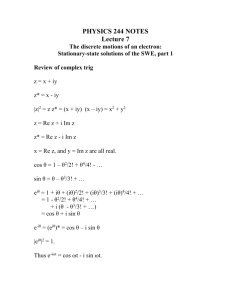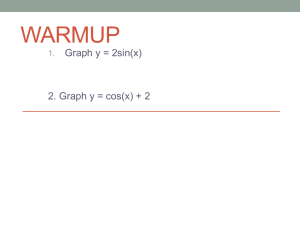
UNIVERSAL SERIES BY TRIGONOMETRIC SYSTEM
IN WEIGHTED L1μ SPACES
S. A. EPISKOPOSIAN
Received 17 April 2006; Accepted 9 November 2006
We consider the question of existence of trigonometric series universal in weighted
L1μ [0,2π] spaces with respect to rearrangements and in usual sense.
Copyright © 2006 Hindawi Publishing Corporation. All rights reserved.
1. Introduction
Let X be a Banach space.
Definition 1.1. A series
∞
fk ,
fk ∈ X,
(1.1)
k =1
is said to be universal in X with respect to rearrangements,
if for any f ∈ X the members
of (1.1) can be rearranged so that the obtained series ∞
k=1 fσ(k) converges to f by norm
of X.
Definition 1.2. The series (1.1) is said to be universal (in X) in the usual sense, if for any
f ∈ X there exists a growing sequence of natural numbers nk such that the sequence of
partial sums with numbers nk of the series (1.1) converges to f by norm of X.
Definition 1.3. The series (1.1) is said to be universal
(in X) concerning partial series, if
for any f ∈ X it is possible to choose a partial series ∞
k=1 fnk from (1.1), which converges
to the f by norm of X.
Note that many papers are devoted (see [1–10]) to the question on existence of various
types of universal series in the sense of convergence almost everywhere and on a measure.
The first usual universal in the sense of convergence almost everywhere trigonometric
series were constructed by Menshov [6] and Kozlov [5]. The series of the form
∞
1 + ak coskx + bk sinkx
2 k =1
Hindawi Publishing Corporation
International Journal of Mathematics and Mathematical Sciences
Volume 2006, Article ID 62909, Pages 1–13
DOI 10.1155/IJMMS/2006/62909
(1.2)
2
Universal series by trigonometric system
was constructed just by them such that for any measurable-on-[0,2π] function f (x) there
exists the growing sequence of natural numbers nk such that the series (1.2) having the sequence of partial sums with numbers nk converges to f (x) almost everywhere on [0,2π].
(Note here that in this result, when f (x) ∈ L1[0,2π] , it is impossible to replace convergence
almost everywhere by convergence in the metric L1[0,2π] ).
This result was distributed by Talaljan on arbitrary orthonormal complete systems
(see [8]). He also established (see [9]) that if {φn (x)}∞
n=1 —the normalized basis of space
p
L[0,1] , p > 1, then there exists a series of the form
∞
ak φk (x),
ak −→ 0,
(1.3)
k =1
which has property: for any measurable function f (x) the members of series (1.3) can be
rearranged so that the again received series converge on a measure on [0,1] to f (x).
Orlicz [7] observed the fact that there exist functional series that are universal with
respect to rearrangements in the sense of a.e. convergence in the class of a.e. finite measurable functions.
It is also useful to note that even Riemann proved that every convergent numerical
series which is not absolutely convergent is universal with respect to rearrangements in
the class of all real numbers.
Let μ(x) be a measurable-on-[0,2π] function with 0 < μ(x) ≤ 1, x ∈ [0,2π], and let
L1μ [0,2π] be a space of measurable functions f (x), x ∈ [0,2π], with
2π
0
f (x)μ(x)dx < ∞.
(1.4)
Grigorian constructed a series of the form (see [3])
∞
Ck eikx
with
k=−∞
∞
q
Ck < ∞ ∀q > 2,
(1.5)
k=−∞
which is universal in L1μ [0,2π] concerning partial series for some weighted function μ(x),
0 < μ(x) ≤ 1, x ∈ [0,2π].
∞
In [2] it is proved that for any given sequence of natural numbers {λm }∞
m=1 with λm there exists a series by trigonometric system of the form
∞
Ck eikx ,
C−k = C k ,
(1.6)
k =1
with
m
ikx
≤ λm ,
C
e
k
x ∈ [0,2π], m = 1,2,...,
(1.7)
k =1
so that for each ε > 0 a weighted function μ(x),
0 < μ(x) ≤ 1,
x ∈ [0,2π] : μ(x) = 1 < ε,
(1.8)
S. A. Episkoposian 3
can be constructed so that the series (1.6) is universal in the weighted space L1μ [0,2π] with
respect simultaneously to rearrangements as well as to subseries.
In this paper, we prove the following results.
Theorem 1.4. There exists a series of the form
∞
Ck eikx
∞
q
Ck < ∞ ∀q > 2
with
k=−∞
(1.9)
k=−∞
such that for any number ε > 0 a weighted function μ(x), 0 < μ(x) ≤ 1, with
x ∈ [0,2π] : μ(x) = 1 < ε
(1.10)
can be constructed so that the series (1.9) is universal in L1μ [0,2π] with respect to rearrangements.
Theorem 1.5. There exists a series of the form (1.9) such that for any number > 0 a
weighted function μ(x) with (1.10) can be constructed so that the series (1.9) is universal in
L1μ [0,2π] in the usual sense.
2. Basic lemma
Lemma 2.1. For any given numbers 0 < ε < 1/2, N0 > 2, and a step function
f (x) =
q
γs · χΔs (x),
(2.1)
s =1
m
m
m
where Δs is an interval of the form Δ(i)
m = (i − 1)/2 , i/2 , 1 ≤ i ≤ 2 , and
−1
2π
3
2
γs · Δs < · 8 ·
f (x)dx
,
s = 1,2,..., q,
0
(2.2)
there exists a measurable set E ⊂ [0,2π] and a polynomial P(x) of the form
P(x) =
Ck eikx ,
(2.3)
N0 ≤|k|<N
which satisfy the conditions
E
|E| > 2π − ε,
P(x) − f (x)dx < ε,
(2.4b)
2+ε
Ck < ε,
(2.4c)
N0 ≤|k|<N
max
N0 ≤m<N
e
N0 ≤|k|≤m
for every measurable subset e of E.
ikx (2.4a)
C−k = C k ,
Ck e dx < ε +
e
f( x)dx
(2.4d)
4
Universal series by trigonometric system
Proof. Let 0 < < 1/2 be an arbitrary number.
Set
g(x) = 1 if x ∈ [0,2π] \
ε · π 3ε · π
,
,
2
2
(2.5)
ε · π 3ε · π
if x ∈
,
.
2
2
2
g(x) = 1 −
ε
(2.6)
We choose natural numbers ν1 and N1 so large that the following inequalities be satisfied:
2π
1 2π 0
ε
g1 (t)e−ikt dt <
16 · N0
|k | < N0 ,
,
(2.7)
where
g1 (x) = γ1 · g ν1 · x · χΔ1 (x).
(2.8)
(By χE (x) we denote the characteristic function of the set E.) We put
E1 = x ∈ Δs : gs (x) = γs .
(2.9)
By (2.5), (2.8), and (2.9) we have
E1 > 2π · (1 − ) · Δ1 ,
2π
0
g1 (x) = 0,
x ∈ Δ1 ,
2 2 · γ1 · Δ1 .
g12 (x)dx <
(2.10)
(2.11)
2
Since the trigonometric system {eikx }∞
k=−∞ is complete in L [0,2π], we can choose a natural number N1 > N0 so large that
2π 0 Ck(1) eikx
0≤|k|<N1
ε
− g1 (x)dx ≤ ,
8
(2.12)
where
Ck(1)
1
=
2π
2π
0
g1 (t)e−ikt dt.
(2.13)
Hence by (2.7), (2.8), and (2.12) we obtain
2π 0 N0 ≤|k|<N1
Ck(1) eikx
ε
− g1 (x)dx ≤ +
8
0≤|k|<N0
(1) 2
Ck 1/2
ε
< .
4
(2.14)
Now assume that the numbers ν1 < ν2 < · · · νs−1 , N1 < N2 < · · · < Ns−1 , functions g1 (x),
g2 (x),...,gs−1 (x), and the sets E1 ,E2 ,...,Es−1 are defined. We take sufficiently large natural
S. A. Episkoposian 5
numbers νs > νs−1 and Ns > Ns−1 to satisfy
1 2π 2π
0
gs (t)e
−ikt
2π 0 ε
dt <
,
16 · Ns−1
Ck(s) eikx
0≤|k|<Ns
1 ≤ s ≤ q, |k| < Ns−1 ,
ε
− gs (x)dx ≤ s+1 ,
4
(2.15)
(2.16)
where
Ck(s) =
gs (x) = γs · g(νs · x) · χΔs (x),
1
2π
2π
0
gs (t)e−ikt dt.
(2.17)
Set
Es = x ∈ Δs : gs (x) = γs .
(2.18)
Using the above arguments (see (2.19)–(2.21)), we conclude that the function gs (x) and
the set Es satisfy the conditions
Es > 2π · (1 − ) · Δs ;gs (x) = 0,
2π
2π 0 0
2 2 · γs · Δs ,
gs2 (x)dx <
Ns−1 ≤|k|<Ns
x ∈ Δs ,
(2.19)
(2.20)
ε
.
2s+1
Ck(s) eikx − g1 (x)
dx <
(2.21)
Thus, by induction, we can define natural numbers ν1 < ν2 < · · · νq , N1 < N2 < · · · < Nq ,
functions g1 (x),g2 (x),...,gq (x), and sets E1 ,E2 ,...,Eq such that conditions (2.17)–(2.19)
are satisfied for all s, 1 ≤ s ≤ q. We define a set E and a polynomial P(x) as follows:
E=
q
Es ,
(2.22)
s =1
P(x) =
Ck e
ikx
N0 ≤|k|<N
q
=
s =1
Ck(s) eikx
,
C−k = C k ,
(2.23)
Ns−1 ≤|k|<Ns
where
Ck = Ck(s)
for Ns−1 ≤ |k| < Ns , s = 1,2,..., q, N = Nq − 1.
(2.24)
By Bessel’s inequality and (2.5), (2.17) for all s ∈ [1, q] we get
Ns−1 ≤|k|<Ns
(s) 2
Ck 1/2
≤
2π
o
1/2
gs2 (x)dx
2 ≤ √ · γs · Δs ,
ε
(2.25)
s = 1,2,..., q.
6
Universal series by trigonometric system
From (2.5), (2.15), and (2.16), it follows that
|E| > 2π − ε.
(2.26)
Taking relations (2.1), (2.5), (2.13), (2.15), (2.21)–(2.24), we obtain
E
q
P(x) − f (x)dx ≤
s =1
E
Ck(s) eikx
Ns−1 ≤|k|<Ns
− gs (x)dx < ε.
(2.27)
By (2.1), (2.2), (2.23)-(2.24) for any k ∈ [N0 ,N], we have
N
2+
2
Ck Ck ≤ max Ck ·
N 0 ≤k ≤N
N0 ≤|k|<N
≤ max
k =N 0
q
8 · γs · Δs ·
1≤s≤q
≤ max
1≤s≤q
≤ max
s =1
(s) 2
Ck Ns−1 ≤|k|<Ns
q
8 8 2 · γs · Δs · · γs · Δs s =1
(2.28)
1
8 8
2
· γs · Δs · ·
f (x)dx < ;
1≤s≤q
0
that is, the statements (2.4a)–(2.4c) of Lemma 2.1 are satisfied. Now we will check the
fulfillment of statement (2.4d) of Lemma 2.1. Let N0 ≤ m < N, then for some s0 ,1 ≤ s0 ≤
q, (Ns0 ≤ m < Ns0 +1 ) we will have (see (2.23) and (2.24))
Ck e
ikx
=
s0
s =1
N0 ≤|k|≤m
Ck(s) eikx
Ns−1 ≤|k|<Ns
+
Ck(s0 +1) eikx .
(2.29)
Ns0 −1 ≤|k|≤m
Hence and from (2.1), (2.2), (2.5), (2.21), (2.22), and (2.25) for any measurable set e ⊂ E,
we obtain
e
Ns−1 ≤|k|≤m
s0 ≤
s =1
+
<
Ck eikx dx
e
s0 s =1 e
s0
ε
2s+1
s =1
Ck(s) eikx
Ns−1 ≤|k|<Ns
gs (x)dx +
+
e
e
− gs (x)dx
Ns0 −1 ≤|k|≤m
f (x)dx + √2 · γs +1 · Δs +1 <
0
0
ε
(2.30)
Ck(s0 +1) eikx dx
e
f (x)dx + ε.
S. A. Episkoposian 7
3. Proof of theorems
Proof of Theorem 1.5. Let
x ∈ [0,2π],
f1 (x), f2 (x),..., fn (x),
(3.1)
be a sequence of all step functions, values, and constancy interval endpoints of which are
rational numbers. Applying lemma consecutively, we can find a sequence {Es }∞
s=1 of sets
and a sequence of polynomials
Ps (x) =
Ck(s) eikx ,
Ns−1 ≤|k|<Ns
(3.2)
1 = N0 < N1 < · · · < N s < · · · ,
s = 1,2,...,
which satisfy the conditions
Es > 1 − 2−2(s+1) ,
Es ⊂ [0,2π],
Ps (x) − fs (x)dx < 2−2(s+1) ,
Es
(s) 2+2−2s
C < 2−2s ,
k
max
Ns−1 ≤|k|≤ p
(3.4)
(s)
C−(s)k = C k ,
Ns−1 ≤|k|<Ns
Ns−1 ≤ p<Ns
e
(3.3)
Ck eikx dx < 2−2(s+1) +
e
fs (x)dx
(3.5)
(3.6)
for every measurable subset e of Es .
Denote
∞
Ck eikx =
∞
s =1
k=−∞
Ck(s) eikx ,
(3.7)
Ns−1 ≤|k|<Ns
where Ck = Ck(s) for Ns−1 ≤ |k| < Ns , s = 1,2,....
Let ε be an arbitrary positive number. Setting
Ωn =
E = Ωn 0 =
B=
∞
n =n 0
∞
Es ,
n = 1,2,...,
Es ,
n0 = log1/2 ε + 1,
(3.8)
s =n
∞
s =n 0
Ωn = Ωn 0
∞
n=n0 +1
It is clear (see (3.3)) that |B | = 2π and |E| > 2π − ε.
(3.9)
Ω n \ Ω n −1 .
(3.10)
8
Universal series by trigonometric system
We define a function μ(x) in the following way:
μ(x) = 1 for x ∈ E ∪ [0,2π] \ B ,
(3.11)
for x ∈ Ωn \ Ωn−1 , n ≥ n0 + 1,
μ(x) = μn
where
4n
μn = 2 ·
n
−1
hs
(3.12)
,
s =1
hs = fs (x)C +
max Ns−1 ≤ p<Ns Ns−1 ≤|k|≤ p
Ck(s) eikx + 1,
(3.13)
C
where
g(x) = max g(x),
C
(3.14)
x∈[0,2π]
g(x) is a continuous function on [0,2π].
From (3.5), (3.7)–(3.12), we obtain the following.
(A) 0 < μ(x) ≤ 1, μ(x) is a measurable function and
x ∈ [0,2π] : μ(x) = 1 < ε.
(3.15)
q
(B) ∞
k=1 |Ck | < ∞ for all q > 2.
Hence, obviously, we have
lim Ck = 0.
(3.16)
k→∞
It follows from (3.9)–(3.12) that for all s ≥ n0 and p ∈ [Ns−1 ,Ns ),
[0,2π]\Ωs Ns−1 ≤|k|≤ p
Ck(s) eikx μ(x)dx =
≤
∞
n=s+1
∞
2
Ωn \Ωn−1 −4n
n=s+1
2π 0 Ns−1 ≤|k|≤ p
Ns−1 ≤|k|≤ p
Ck(s) eikx μ dx
n
−1
Ck(s) eikx h dx
s
< 2−4s .
(3.17)
By (3.4), (3.9)–(3.12) for all s ≥ n0 , we have
2π
0
Ps (x) − fs (x)μ(x)dx
=
Ωs
Ps (x) − fs (x)μ(x)dx
= 2−2(s+1) +
∞
n=s+1
Ωn \Ωn−1
+
[0,2π]\Ωs
Ps (x) − fs (x)μ(x)dx
Ps (x) − fs (x)μn dx
S. A. Episkoposian 9
≤2
−2(s+1)
∞
+
2
−4s
2π
0
n=s+1
fs (x) + Ns−1 ≤|k|<Ns
Ck(s) eikx −1
hs dx
< 2−2(s+1) + 2−4s < 2−2s .
(3.18)
Taking
relations
(3.6), (3.9)–(3.12), and (3.17) into account we obtain that for all p ∈
Ns−1 ,Ns and s ≥ n0 + 1,
2π 0 Ns−1 ≤|k|≤ p
=
Ωs Ns−1 ≤|k|≤ p
s
Ck(s) eikx μ(x)dx +
Ωn \Ωn−1 n=n0 +1
<
s
<
Ck(s) eikx μ(x)dx
2−2(s+1) +
n=n0 +1
2π
<
0
Ns−1 ≤|k|≤ p
Ωn \Ωn−1
μn +
n=n0 +1
[0,2π]\Ωs Ns−1 ≤|k|≤ p
Ck(s) eikx μ(x)dx
(s) ikx Ck e dx · μn + 2−4s
s
= 2−2(s+1) ·
Ωs
(3.19)
fs (x)dx μn + 2−4s
fs (x)μ(x)dx + 2−4s
fs (x)μ(x)dx + 2−4s .
2π
Let f (x) ∈ L1μ [0,2π], that is, 0 | f (x)|μ(x)dx < ∞.
It is easy to see that we can choose a function fν1 (x) from the sequence (3.1) such that
2π
0
f (x) − fν (x)μ(x)dx < 2−2 ,
1
ν1 > n0 + 1.
(3.20)
f (x)μ(x)dx.
(3.21)
Hence, we have
2π
0
fν (x)μ(x)dx < 2−2 +
1
2π
0
From (2.1), (A), (3.18), and (3.20), we obtain with m1 = 1,
2π
0
f (x) − Pν (x) + Cm eim1 x μ(x)dx
1
1
≤
2π
0
f (x) − fν (x)μ(x)dx +
1
2π
+
0
2π
0
fν (x) − Pν (x)μ(x)dx
1
1
Cm eim1 x μ(x)dx < 2 · 2−2 + 2π · Cm .
1
1
(3.22)
10
Universal series by trigonometric system
Assume that numbers ν1 < ν2 < · · · < νq−1 , m1 < m2 < · · · < mq−1 are chosen in such a
way that the following condition is satisfied:
2π j
ims x f (x) −
μ(x)dx < 2 · 2−2 j + 2π · Cm j ,
Pνs (x) + Cms e
0 1 ≤ j ≤ q − 1.
s =1
(3.23)
We choose a function fνq (x) from the sequence (3.1) such that
2π q −1
im
x
s
f (x) −
P
(x)
+
C
e
− fnq (x)μ(x)dx < 2−2q ,
ν
m
s
s
0 (3.24)
s =1
where νq > νq−1 ; νq > mq−1
This, with (3.23), implies
2π
0
fν (x)μ(x)dx < 2−2q + 2 · 2−2(q−1) + 2π · Cm = 9 · 2−2q + 2π · CM .
q
q−1
q−1
(3.25)
By (3.18), (3.19), and (3.25) we obtain
2π
0
fν (x) − Pν (x)μ(x)dx < 2−2νq ,
q
q
Pνq (x) =
(3.26)
(νq )
Ck eikx ,
Nνq −1 ≤|k|<Nνq
2π p
(νq ) ikx μ(x)dx < 10 · 2−2q + 2π · Cmq−1 .
max
C
e
k
Nνq −1 ≤ p<Nνq 0 (3.27)
k=Nνq −1
Denote
mq = min n ∈ N : n ∈
N ν −1
{k }k=sNνs −1
q
s =1
∪ ms
q −1
s =1
.
From (2.1), (A), (3.24), and (3.26), we have
2π q
im
x
f (x) −
Pνs (x) + Cms e s μ(x)dx
0 s =1
2π q −1
ims x
f (x) −
μ(x)dx
≤
P
(x)
+
C
e
f
(x)
−
ν
m
ν
s
s
q
0 s =1
(3.28)
S. A. Episkoposian 11
2π
+
0
2π
+
0
fν (x) − Pν (x)μ(x)dx
q
q
Cm eimq x μ(x)dx < 2 · 2−2q + 2π · Cm .
q
q
(3.29)
Thus, by induction we, on q, can choose from series (3.7) a sequence of members
Cmq eimq x ,
q = 1,2,...,
(3.30)
and a sequence of polynomials
Pνq (x) =
(νq )
Ck eikx ,
Nnq −1 > Nnq−1 , q = 1,2,...
(3.31)
Nνq −1 ≤|k|<Nνq
such that conditions (3.27)–(3.29) are satisfied for all q ≥ 1.
Taking account the choice of Pνq (x) and Cmq eimq x (see (3.28) and (3.31)), we conclude
that the series
∞
q =1
(νq )
Ck eikx + Cmq eiqx
(3.32)
Nνq −1 ≤|k|<Nνq
is
obtained from the series (3.7) by rearrangement of members. Denote this series by
Cσ(k) eiσ(k)x .
It follows from (3.16), (3.27), and (3.29) that the series Cσ(k) eiσ(k)x converges to the
function f (x) in the metric L1μ [0,2π], that is, the series (3.7) is universal with respect to
rearrangements (see Definition 1.1).
Proof of Theorem 1.5. Applying Lemma 2.1 consecutively, we can find a sequence {Es }∞
s =1
of sets and a sequence of polynomials
Ps (x) =
(s)
Ck(s) eikx ,
C−(s)k = C k ,
Ns−1 ≤|k|<Ns
(3.33)
1 = N0 < N1 < · · · < N s < · · · ,
s = 1,2,...,
which satisfy the conditions
Es > 1 − 2−2(s+1) ,
Es ⊂ [0,2π],
(s) 2+2−2s
C < 2−2s ,
k
Ns−1 ≤|k|<Ns
n
fn (x) − Ps (x)dx < 2−n ,
En
n = 1,2,...,
(3.34)
(3.35)
(3.36)
s =1
where { fn (x)}∞
n=1 , x ∈ [0,2π], is a sequence of all step functions, values, and constancy
interval endpoints of which are rational numbers.
12
Universal series by trigonometric system
Denote
∞
Ck eikx =
∞
s =1
k=−∞
Ck(s) eikx ,
(3.37)
Ns−1 ≤|k|<Ns
where Ck = Ck(s) for Ns−1 ≤ |k| < Ns , s = 1,2,... .
It is clear (see (3.35)) that
∞
q
Ck < ∞
∀q > 2.
(3.38)
k =1
Repeating reasoning of Theorem 1.4, a weighted function μ(x), 0 < μ(x) ≤ 1, can be
constructed so that the following condition is satisfied:
2π n
fn (x) − Ps (x) · μ(x)dx < 2−2n ,
0 n = 1,2,....
(3.39)
s =1
For any function f (x) ∈ L1μ [0,1], we can choose a subsystem { fnν (x)}∞
ν=1 from the sequence (3.1) such that
2π
0
f (x) − fn (x)μ(x)dx < 2−2ν .
ν
(3.40)
From (3.37)–(3.40), we conclude
2π 2π nν ikx
f (x) −
f (x) −
Ck e μ(x)dx =
0 0 s =1
|k |≤Mν
≤
2π
0
Ck(s) eikx
Ns−1 ≤|k|<Ns
μ(x)dx
f (x) − fν (x) · μ(x)dx
k
2π νk
fνk (x) − Ps (x) · μ(x)dx < 2−2k + 2−2νk ,
+
0
s=1
(3.41)
where Mν = Nnν − 1.
Thus, the series (3.37) is universal in L1μ [0,1] in the sense of usual (see Definition 1.2).
Theorem 1.5 is proved.
Acknowledgments
The author was supported in part by Grant 01-000 from the Government of Armenia.
The author thanks Professor M. G. Grigorian for his attention to this paper.
S. A. Episkoposian 13
References
[1] F. G. Arutjunjan, Representation of functions by multiple series, Akademiya Nauk Armyanskoı̆
SSR. Doklady 64 (1977), no. 2, 72–76.
[2] S. A. Episkoposian, On the existence of universal series by trigonometric system, Journal of Functional Analysis 230 (2006), no. 1, 169–183.
[3] M. G. Grigorian, On the representation of functions by orthogonal series in weighted L p spaces,
Studia Mathematica 134 (1999), no. 3, 207–216.
[4] M. G. Grigorian and S. A. Episkoposian, Representation of functions in the weighted space
L1μ [0,2π] by trigonometric and Walsh series, Analysis Mathematica 27 (2001), no. 4, 261–277.
[5] V. Ya. Kozlov, On complete systems of orthogonal functions, Matematicheskiı̆ Sbornik 26(68)
(1950), 351–364.
[6] D. E. Menshov, On the partial summs of trigonometric series, Matematicheskiı̆ Sbornik 20 (1947),
197–238.
[7] W. Orlicz, Uber die unabhangig von der Anordnung fast uberall kniwergenten Reihen, Bulletin de
l’Académie Polonaise des Science 81 (1927), 117–125.
[8] A. A. Talaljan, On the convergence almost everywhere of subsequences of partial sums of general
orthogonal series, Izvestiya Akademii Nauk SSSR. Seriya Matematicheskaya 10 (1957), no. 3, 17–
34.
, Series universal with respect to rearrangement, Izvestiya Akademii Nauk SSSR. Seriya
[9]
Matematicheskaya 24 (1960), 567–604.
[10] P. L. Ul’yanov, Unconditional convergence and summability, Izvestiya Akademii Nauk SSSR.
Seriya Matematicheskaya 22 (1958), 811–840.
S. A. Episkoposian: Chair of Higher Mathematics, Faculty of Physics, Yerevan State University,
Alex Manoogian street 1, Yerevan 375049, Armenia
E-mail address: sergoep@ysu.am






